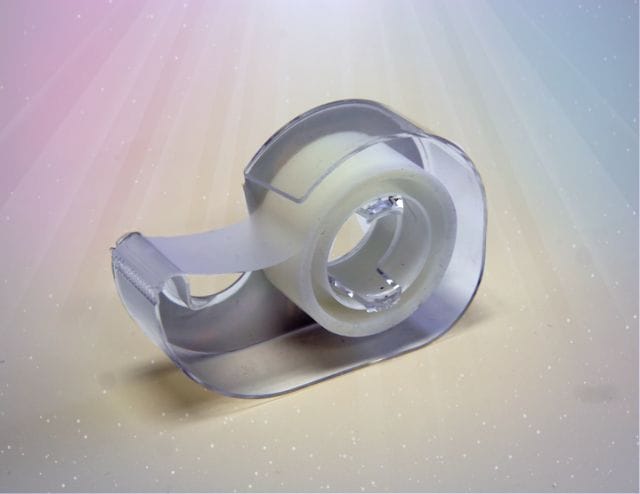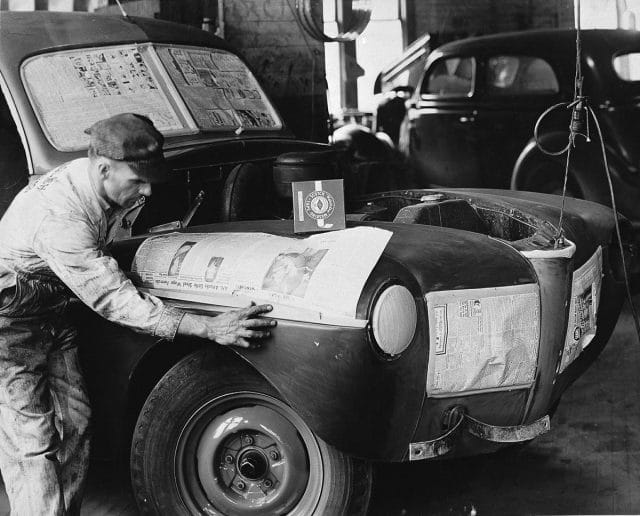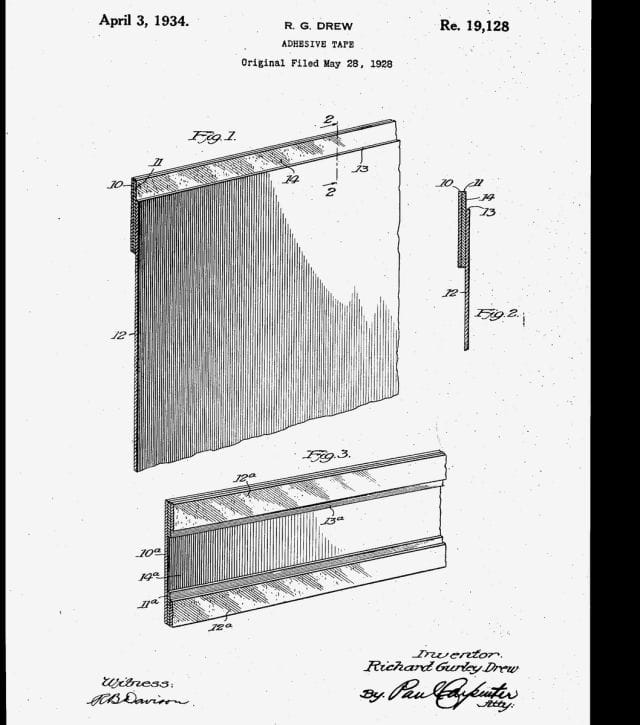
“He created a greenhouse environment, a skunkworks, where we could do anything, try anything. When you’re an oddball in a permissive environment, things often turn out well.”
— Paul Hanson, ex-technical director at 3M, on Scotch tape inventor, Richard Drew
![]()
On a surface level, Scotch tape may seem like just about the most boring product in the world. Though it can be found in nearly 90% of American households and is used for everything from wrapping gifts to “repairing” ripped dollar bills, we’ll forgive you for never being curious about its origins. But stick with us: this gets interesting!
The story of Scotch tape is one of incredible determination and risk-taking — and its invention was thanks to a banjo-playing, college-dropout, “misfit” engineer who believed in his ability to invent.
He ended up not just pioneering Scotch transparent tape and masking tape, but revolutionizing the way that his company, 3M, treated creative people.
A Brief History of 3M
Though today’s consumers recognize 3M as a manufacturer of sandpaper, tape, and other adhesives, the company initially attempted to break into a completely different market.
In 1902, five Minnesota businessmen pooled their resources to start a mining venture, Minnesota Mining & Manufacturing Co (3M). With the goal of extracting and selling corundum, an abrasive mineral, the men purchased a mine. But when the mine failed to turn up anything of value, the project faltered and changed hands. Its new owners set out on a mission to invent a superior sandpaper.
Without corundum, 3M turned to importing a different mineral, garnet, from Spain. Though garnet proved gritty enough to make sandpaper with, it was far from ideal. Hundreds of letters poured in from customers complaining that the ground up minerals weren’t adhering to the sandpaper. After a decade of research, development, and hard work, 3M still found itself struggling to turn a profit.
Then, in the early 1920s, the company’s management decided to diversify its product line. It was a strategy that paid off big — especially when they hired an engineer named Richard Drew.
The Scrappy Engineer
In 1921, 3M hired three men to oversee product innovation — a move that the company itself cites as “one of the most harmonic convergences in the annals of business.” Among the men was one Richard Drew.
From a young age, Drew expressed disinterest in the traditional American workplace. Throughout his youth and well into his teens, he pursued a career as a banjo player. After touring with local dance bands for a number of years, he scraped together enough money to pay for a mechanical engineering degree at the University of Minnesota. Just 18 months into the program, Drew grew dissatisfied and dropped out. Instead, he turned to the local classified ads, saw a listing for a job at 3M, and decided, on a whim, to go for it, complete with a quintessential application letter:
“I have not as yet been employed in commercial work and am eager to get started. I realize that my services would not be worth much until a certain amount of practical experience is gained, and I would be glad to start with any salary you see fit to give…I am accustomed to physical labor, if this be required, as I drove a tractor and did general farm work.”
The 22-year-old was hired, and thrown into the lower dregs of 3M: for two years, he was tasked with testing out various grains of sandpaper. Eventually, the company sent Drew out to local auto shops, who were 3M’s most frequent customers at the time, to disseminate the sandpapers for testing.

An auto painter struggles with a dual-tone paint job
At the time, in the 1920s, two-tone paint jobs on cars were all the rage. For auto workers, this was a total pain in the ass: To achieve this effect, they had to mask off parts of the car with butcher paper, newspapers, homemade glue, and heavy-duty surgical adhesive tape. When the tape was removed, it would often take with it chips of the freshly-coated paint. A vicious cycle would ensue of taping, painting, re-taping, and re-painting.
When Drew walked into the shop that day, he was greeted with the “choicest profanity” he’d ever heard: strong adhesive tape had, once again, botched the auto workers’ paint job. Instead of seizing the opportunity to sell the disgruntled workers sandpaper to remove paint, Drew had a completely unrelated revelation: what if he could design a superior, less aggressive tape — a tape that didn’t ruin paint jobs?
He made a vow to the auto workers that he’d soon return with a solution, and darted out of the shop.
Taping the Way
Drew had no clue how to make tape. But he realized that as a sandpaper manufacturer, 3M had access to many of the necessary components: after all, creating sandpaper required a sticky surface to which the minerals would be applied.
So, in his time between selling sandpaper, the brash engineer set out to invent his new tape. A series of experiments ensued with various ingredients — vegetable oils, chicle, linseed, glycerin, all types of resins — but nothing really worked. What’s more, as Drew fell behind on his other work, his superiors ordered him to drop his efforts and return to his primary duties.
“(Drew) could back his promise with neither experience nor know-how,” later recalled one overseer at 3M. “He didn’t even know exactly what was needed, but he had the optimism of youth.”
Drew refused to give up, and pursued the tape invention in his own time. Two years later, he found a formula that worked: a mix of cabinet maker’s glue and glycerin applied to a thin, treated crepe paper produced a tape that convincingly stuck to its surface but still peeled off easily and didn’t damage paint.
Drew’s original patent illustration for adhesive tape
His boss, William McKnight, the same man who’d initially ordered Drew to cease his inventing efforts, still didn’t see the potential in this new tape, and refused to purchase a machine that would allow for its mass production. Instead of acquiescing, Drew got creative: as a researcher, he had the right to secure purchases of up to $100, so he bought the machine in parts in a series of $99 orders, then constructed it himself. When Drew’s boss later found out what Drew he’d been up to, he rewarded him for his tenacity by establishing a new managerial mandate at 3M: “If you have the right person on the right project, and they are absolutely dedicated to finding a solution – leave them alone. Tolerate their initiative and trust them.”
Drew’s resulting product — “Scotch Brand Masking Tape” — was an instant success, and immediately changed the way paint jobs of all sorts were completed. But Drew wasn’t done.
The Birth of Scotch Tape
The success of masking tape earned Drew a promotion: by the late 1920s, he was heading 3M’s fabrication laboratory — a position that allowed him great flexibility in innovating new products. Drew took great joy in “finding something valuable in something not even sought out”; much like masking tape, his invention of Scotch tape was serendipitous.
Competing company DuPont had just invented cellophane — a “moisture-proof packaging material” used by bakers, grocers, and meatpackers to wrap their products in. Since cellophane was transparent, these sellers sought an attractive way to seal the wrapping.
For a year, Drew and his team embarked on a challenging mission to produce a tape with clear, cellophane backing. The material was fickle, recalls a 3M historian:
“The cellophane curled near heat and split as it was being coated by machine. It often broke or tore before a full roll was coated. The adhesive wouldn’t adhere evenly. The dark amber adhesive spoiled the look of the colorless, transparent cellophane.”
So, Drew designed his own machinery that treated the delicate tape more sensitively. After various pursuits, a clear tape was created from “oils, resins, and rubber” — and it was completely see-through.

Scotch Tape in its original packaging (c.1930s)
In September 1930, the product, Scotch® Brand Cellulose Tape (later renamed Scotch Transparent Tape) was released and its initial users championed its usefulness. As the Great Depression set in, 3M’s tapes conversely thrived: instead of purchasing new products in the economically bleak times, consumers enlisted Scotch tape to “repair and restore” broken items around the house. According to 3M, the tape “virtually sold itself”:
“Almost daily, new ideas sprang up for using the tape to make old things do. It was used to mend book pages, sheet music, window curtains, and even small rips in clothing. Bankers used it to repair paper currency. Secretaries found it perfect for patching broken fingernails. Farmers discovered they could use it to seal cracked eggs. Housewives used it to cap canned milk, remove lint from clothing, secure bait on mousetraps, and repair cracked ceiling plaster. Goodyear used the tape to cover the inner ribs and beams of its dirigibles, creating an anti-corrosive shield.”
Riding on the immense success of Drew’s Scotch tapes, 3M financially thrived. While other companies folded and laid off hundreds of employees in the 1930s, 3M grew its team and continued to innovate.
The Legacy of Richard Drew
During World War II, Drew was promoted again — this time becoming the head of a small team known as the Products Fabrication Laboratory, or “Pro-Fab Lab.” Like many companies, 3M’s production was diverted to the nation’s war efforts: over 100 types of adhesives, tapes, and abrasives were produced for the army — most of which were pioneered by Drew and his team.
When a superior noticed that Drew was growing a bit dissatisfied — “his free-wheeling style didn’t fit the company’s organized, technical approach to product development” — he gave Drew the opportunity to form his own team and focus on inventing. With four other employees, Drew moved his research lab into a tiny building that was once used as a whiskey distillery. “It was extremely well-built, but it had large factory windows,” recalls one ex-employee:
“We were right next to a railroad switching yard with a steam locomotive that spouted cinders. With no air conditioning, it was hot. One day, I remember a reading of 107 degrees Fahrenheit in the building. It was hard to conduct experiments.”
In assembling and building out his team, Drew grew a reputation as a quirky, off-kilter leader. Ray Hunder, who was hired by Drew to work on the precursor to Post-It Notes, fondly looks back on his boss’s philosophy:
“Dick never turned anyone away from his office, even though they came in with the strangest ideas. He never discouraged people. He thought of himself as a bit of an underdog and he had compassion for others like him. He allowed his lab team to freely follow their instincts. Dick encouraged people to be themselves. He’d say, ‘Hey, your idea’s as good as anybody else’s.’ When people can be themselves, they use their gifts and talents to the fullest.”
Drew also held no stock in an applicant’s educational background. “He felt that even if you flunked kindergarten, if you stayed in motion, you’d get things done,” later said Ted “Flipper” Buchholtz. With no formal education, Buchholtz was hired by Drew and would later go on to invent Scotch’s now-immensely profitable mounting tape.
Soon, the Pro-Fab Lab became the butt of jokes within 3M. It was dubbed “the funny farm” by upper-level executives, and Drew’s team gained a reputation for employing the “misfits” who didn’t fit in anywhere else. Nonetheless, the team’s focus remained on innovation.
“There was complete freedom to build and do,” recalls John Pearson, who once worked under Drew. “I could purchase stuff and build things, and the engineering department agreed to a hands-off policy.”
“Dick created an environment where people were always encouraged,” adds another ex-employee. “He created a greenhouse environment—a skunkworks—where we could do anything, try anything. When you’re an oddball in a permissive environment, very often things turn out well.”
At the core of this “oddball” environment was a new concept that Drew had introduced to 3M: workers were encouraged to spend up to 15% of their work day innovating and developing their own products (similar strategies have since been integrated at Google and other tech companies). This ended up producing a series of very profitable breakthroughs: Scotchlite reflective sheeting, Micropore surgical tape, foam tape, decorative ribbon, face masks, and respirators among them.
![]()
In 1980, at age 81, Richard Drew passed away. He’d spent more than 40 years at 3M as an inventor, two decades more as a contractor, and had 30 patents to his name.
Today, the technologies he created in Pro-Fab Labs account for more than 20 percent of 3M’s sales. His Scotch Transparent Tape remains the crown jewel of 3M’s immense, multi-billion dollar product line, and can be found in nearly 90% of American homes. It is an invention that is nearly ubiquitous, according to the American Chemical Society: “the tape has been to the moon (as insulation on a lunar lander), has been featured on Saturday Night Live, and has been immortalized in fine art.”
He’s since been inducted into the National Inventors Hall of Fame — an elite group of innovators who made products that shape our world today. But Drew’s legacy extends deeper than the manifestation of a physical product, says old co-worker Paul E. Hansen.
“The reward for persistence is internal,” he writes. “The person who is persistent and eventually succeeds is usually only recognized for accomplishing the feat; seldom does anyone appreciate all that went into making the success a reality.”
***
For more stories about innovators, entrepreneurs, and creative people, check out our latest book → Hipster Business Models!
This post was written by Zachary Crockett. You can follow him on Twitter here.
To get occasional notifications when we write blog posts, please sign up for our email list.




